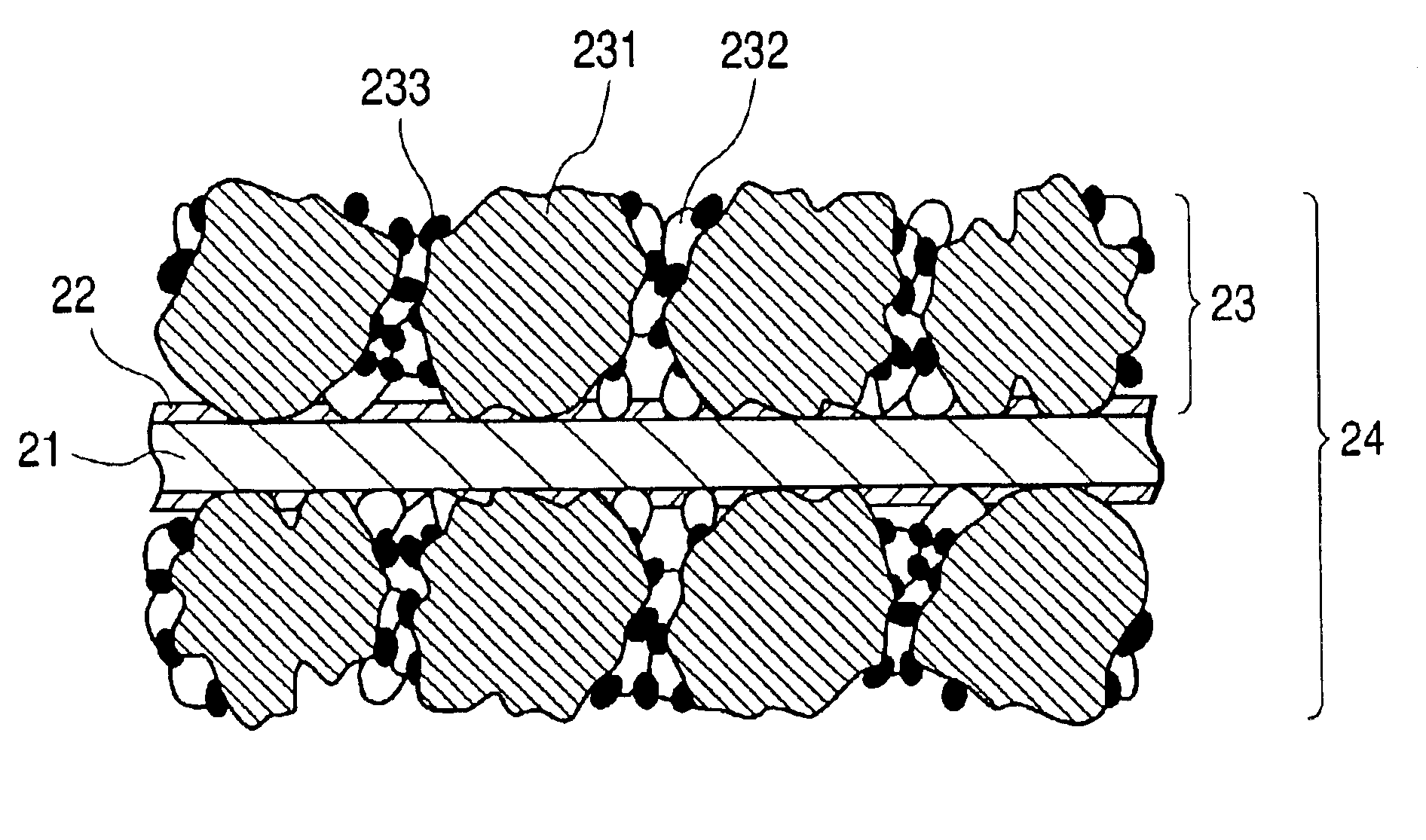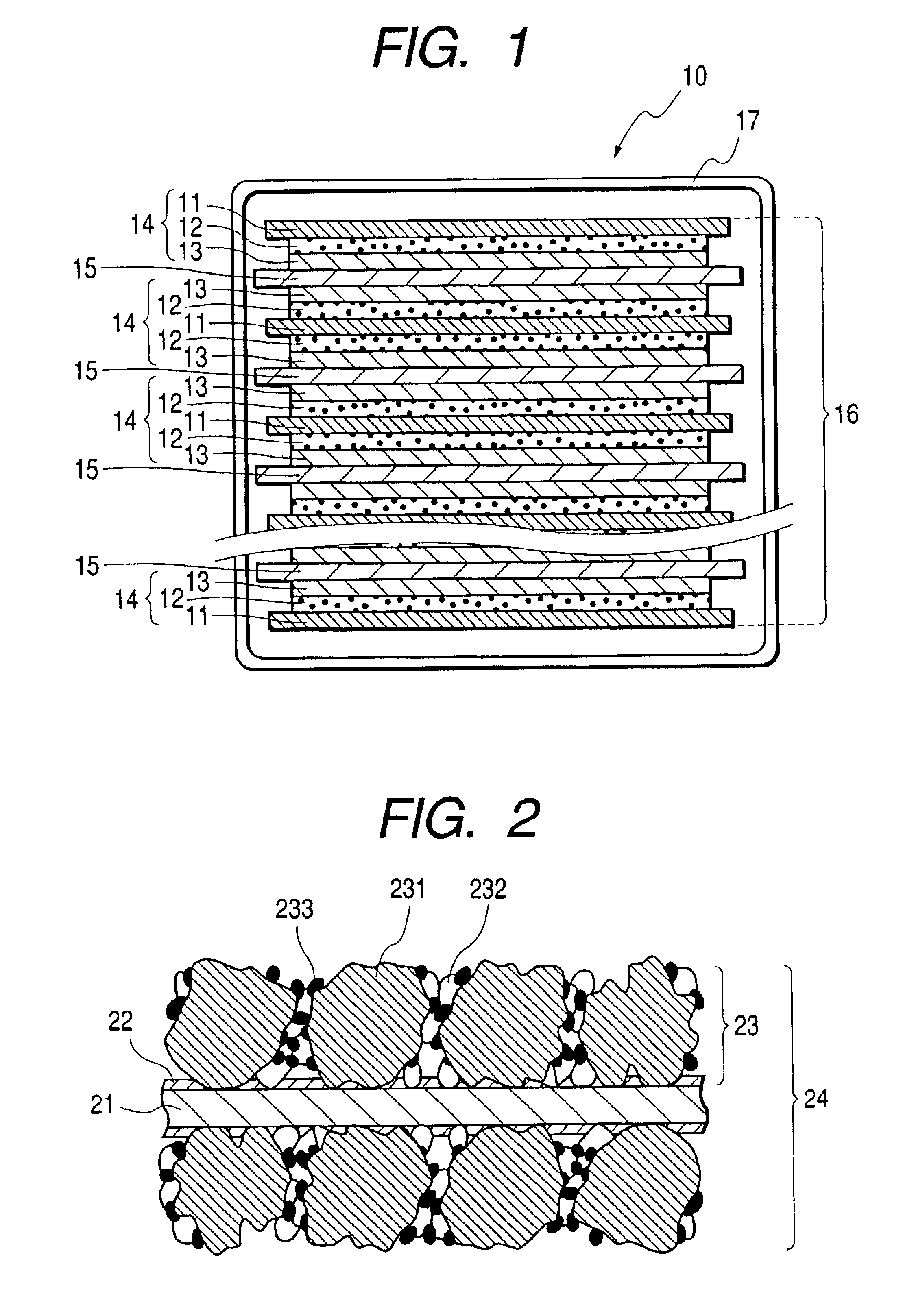Electrochemical device and process for producing same
a technology of electrochemical devices and electrode layers, which is applied in the manufacture of secondary cells, final product manufacturing, and grouping of flat cells, etc., can solve the problems of aluminum foils affecting the adhesion of electrode layers, increasing internal resistance, and deteriorating cycle properties, so as to reduce internal resistance and enhance cycle properties
- Summary
- Abstract
- Description
- Claims
- Application Information
AI Technical Summary
Benefits of technology
Problems solved by technology
Method used
Image
Examples
example 1
(Formation of Adhesive Resin Layer)
[0065]A resin coating liquid was prepared by having an adhesive resin of a fluorine rubber (Viton-GF manufactured by Dupon) dissolved in a solvent of methyl ethyl ketone (MEK: boiling point=80° C.) with the weight ratio Viton-GF / MEK=5 / 95. The methyl ethyl ketone solvent is a good solvent for the fluorine rubber as the adhesive resin. The resin coating liquid thus made was applied to the whole surface of an aluminum foil having a thickness of 20 μm serving as a current collector, so that an adhesive resin layer was formed. The thickness of the adhesive resin layer after the solvent was evaporated was about 0.08 μm.
(Formation of Electrode)
[0066]As an active material, activated carbon fiber having a specific surface area of about 1000 m2 / g, a diameter of 10 μm and a length of about 30 μm was used. The particle diameter of this active material is 30 μm in accordance with the definition of the particle diameter, since the length is larger than the diame...
example 2
[0078]Example 2 of the electric double layer capacitor was made by a process that is basically the same as the process for making example 1 except that the linear pressure of the calender roll during the rolling was set to 1400 kg·f / cm. The same tests and evaluations as those performed on example 1 were also performed on example 2. The results of the tests are shown in Table 2.
[0079]
TABLE 2Example 2RemarksAdhesive resinAdhesive resin layerFluorinelayerrubberLayer thickness (μm)0.08Rolling conditionLinear pressure of calender roll1400(kg · f / cm)AdhesivityCross-cut adhesion test100 / 100goodevaluation(remaining samples / testedsamples)InternalImpedance (Ω)0.27goodresistanceevaluationCycle propertyElectric capacitance in 1st cycle3.1evaluation(F)Electric capacitance in 100th3.1cycle (F)Ratio of change in electric0goodcapacitance (%)
[0080]As seen from the result of the cross-cut adhesion test shown in Table 2, the adhesivity of the electrode layer and the current collector in example 2 was ...
example 3
[0081]Example 3 of the electric double layer capacitor was made by a process that is basically the same as the process for making example 1 except that the rolling process was omitted. The same tests and evaluations as those performed on example 1 were performed on example 3. The results of the tests are shown in Table 3.
[0082]
TABLE 3Example 3RemarksAdhesive resinAdhesive resin layerFluorinelayerrubberLayer thickness (μm)0.08Rolling conditionLinear pressure of calender roll—(kg · f / cm)AdhesivityCross-cut adhesion test100 / 100goodevaluation(remaining samples / testedsamples)InternalImpedance (Ω)0.56goodresistanceevaluationCycle propertyElectric capacitance in 1st cycle3evaluation(F)Electric capacitance in 100th3cycle (F)Ratio of change in electric0goodcapacitance (%)
[0083]As seen from the result of the cross-cut adhesion test shown in Table 3, the adhesivity of the electrode layer and the current collector in example 3 was good or high, and therefore example 3 had good cycle properties....
PUM
| Property | Measurement | Unit |
|---|---|---|
| thickness | aaaaa | aaaaa |
| thickness | aaaaa | aaaaa |
| thickness | aaaaa | aaaaa |
Abstract
Description
Claims
Application Information
 Login to View More
Login to View More - R&D
- Intellectual Property
- Life Sciences
- Materials
- Tech Scout
- Unparalleled Data Quality
- Higher Quality Content
- 60% Fewer Hallucinations
Browse by: Latest US Patents, China's latest patents, Technical Efficacy Thesaurus, Application Domain, Technology Topic, Popular Technical Reports.
© 2025 PatSnap. All rights reserved.Legal|Privacy policy|Modern Slavery Act Transparency Statement|Sitemap|About US| Contact US: help@patsnap.com


